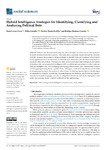Mostrar el registro sencillo del ítem
Hybrid Intelligence Strategies for Identifying, Classifying and Analyzing Political Bots
| dc.contributor.author | García Orosa, Berta | |
| dc.contributor.author | Gamallo, Pablo | |
| dc.contributor.author | Martín-Rodilla, Patricia | |
| dc.contributor.author | Martínez-Castaño, Rodrigo | |
| dc.date.accessioned | 2022-02-17T17:25:39Z | |
| dc.date.available | 2022-02-17T17:25:39Z | |
| dc.date.issued | 2021 | |
| dc.identifier.citation | García-Orosa, B.; Gamallo, P.; Martín-Rodilla, P.; Martínez-Castaño, R. Hybrid Intelligence Strategies for Identifying, Classifying and Analyzing Political Bots. Soc. Sci. 2021, 10, 357. https://doi.org/10.3390/socsci10100357 | es_ES |
| dc.identifier.uri | http://hdl.handle.net/2183/29809 | |
| dc.description | This article belongs to the Special Issue Journalism and Politics: New Influences and Dynamics in the Social Media Era | es_ES |
| dc.description.abstract | [Abstract] Political bots, through astroturfing and other strategies, have become important players in recent elections in several countries. This study aims to provide researchers and the citizenry with the necessary knowledge to design strategies to identify bots and counteract what international organizations have deemed bots’ harmful effects on democracy and, simultaneously, improve automatic detection of them. This study is based on two innovative methodological approaches: (1) dealing with bots using hybrid intelligence (HI), a multidisciplinary perspective that combines artificial intelligence (AI), natural language processing, political science, and communication science, and (2) applying framing theory to political bots. This paper contributes to the literature in the field by (a) applying framing to the analysis of political bots, (b) defining characteristics to identify signs of automation in Spanish, (c) building a Spanish-language bot database, (d) developing a specific classifier for Spanish-language accounts, (e) using HI to detect bots, and (f) developing tools that enable the everyday citizen to identify political bots through framing. | es_ES |
| dc.description.sponsorship | This article has been developed within the research project “Digital Native Media in Spain: Storytelling Formats and Mobile Strategy” (RTI2018–093346-B-C33) funded by the Ministry of Science, Innovation, and Universities and co-funded by the European Regional Development Fund (ERDF) and has received financial support from DOMINO project (PGC2018-102041-B-I00, MCIU/AEI/FEDER, UE), eRisk project (RTI2018-093336-B-C21), the Consellería de Cultura, Educación e Ordenación Universitaria (accreditation 2016–2019, ED431G/08, Groups of Reference: ED431C 2020/21, and ERDF 2014-2020: Call ED431G 2019/04) and the European Regional Development Fund (ERDF) | es_ES |
| dc.description.sponsorship | Xunta de Galicia; ED431G/08 | es_ES |
| dc.description.sponsorship | Xunta de Galicia; ED431C 2020/21 | es_ES |
| dc.description.sponsorship | Xunta de Galicia; ED431G 2019/04 | es_ES |
| dc.language.iso | eng | es_ES |
| dc.publisher | MDPI | es_ES |
| dc.relation.uri | https://doi.org/10.3390/socsci10100357 | es_ES |
| dc.rights | Atribución 4.0 Internacional | es_ES |
| dc.rights.uri | http://creativecommons.org/licenses/by/4.0/ | * |
| dc.subject | Bots | es_ES |
| dc.subject | Framing | es_ES |
| dc.subject | Hybrid intelligence | es_ES |
| dc.subject | Empowerment | es_ES |
| dc.subject | Social media | es_ES |
| dc.title | Hybrid Intelligence Strategies for Identifying, Classifying and Analyzing Political Bots | es_ES |
| dc.type | journal article | es_ES |
| dc.rights.accessRights | open access | es_ES |
| UDC.journalTitle | Social Science | es_ES |
| UDC.volume | 10 | es_ES |
| UDC.issue | 10 | es_ES |
| UDC.startPage | 357 | es_ES |
| dc.identifier.doi | 10.3390/socsci10100357 | |
| UDC.coleccion | Investigación | es_ES |
| UDC.departamento | Ciencias da Computación e Tecnoloxías da Información | es_ES |
| UDC.grupoInv | Information Retrieval Lab (IRlab) | es_ES |
| dc.relation.projectID | info:eu-repo/grantAgreement/AEI/Plan Estatal de Investigación Científica y Técnica y de Innovación 2017-2020/RTI2018–093346-B-C33/ES/CIBERMEDIOS NATIVOS DIGITALES EN ESPAÑA: FORMATOS NARRATIVOS Y ESTRATEGIA MOVIL/ | |
| dc.relation.projectID | info:eu-repo/grantAgreement/AEI/Plan Estatal de Investigación Científica y Técnica y de Innovación 2017-2020/PGC2018-102041-B-I00/ES/TRADUCCION AUTOMATICA NEURONAL, EN DOMINIO, NO SUPERVISADA | |
| dc.relation.projectID | info:eu-repo/grantAgreement/AEI/Plan Estatal de Investigación Científica y Técnica y de Innovación 2017-2020/RTI2018-093336-B-C21/ES/TECNOLOGIAS PARA LA PREDICCION TEMPRANA DE SIGNOS RELACIONADOS CON TRASTORNOS PSICOLOGICOS |
Ficheros en el ítem
Este ítem aparece en la(s) siguiente(s) colección(ones)
-
Investigación (FIC) [1678]






